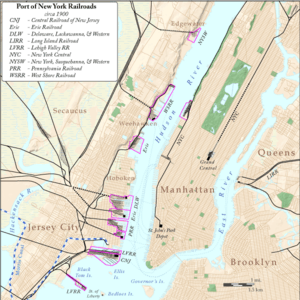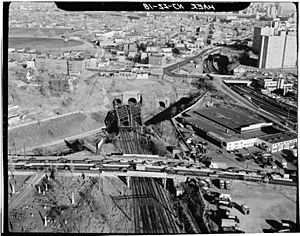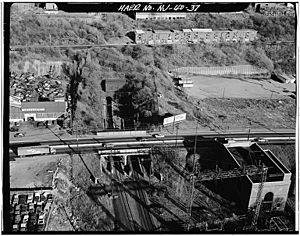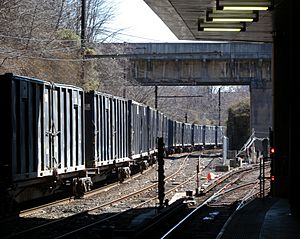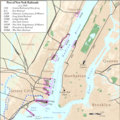Bergen Hill facts for kids
Bergen Hill is a part of the Palisades cliffs in New Jersey, United States. It's located on a piece of land called Bergen Neck, which is between the Hackensack River and the Hudson River. In Hudson County, Bergen Hill reaches about 260 feet high. This area has been very important for transportation for a long time.
Contents
Train Routes Through Bergen Hill
Bergen Hill is famous for its many train routes. In the 1800s and early 1900s, engineers built many cuts (open trenches) and tunnels through the hill. These helped trains reach stations and ferry docks along the North River (Hudson River) and Upper New York Bay. Eventually, tunnels were even built under the river itself!
Here are some of the important train routes and tunnels:
- The Central Railroad of New Jersey lines crossed Newark Bay and went through Bayonne to its station in Jersey City. Parts of this route are now used by the Hudson Bergen Light Rail.
- The Bergen Hill Cut was opened in 1838. It was used by the Pennsylvania Railroad to reach Exchange Place. Today, the PATH trains use this cut for their Journal Square and Newark lines.
- The Erie Cut, also known as the Bergen Arches, was built in 1910 by the Erie Railroad. It's not used anymore.
- The Long Dock Tunnel (1860) was the first Erie Cut. It's now used for freight trains.
- The Bergen Tunnels (1876 and 1908) go under Jersey City Heights. They were built by the Morris and Essex Railroad and are now used by New Jersey Transit trains to Hoboken Terminal.
- The North River Tunnels (1910) are a key part of the Northeast Corridor. Their western entrance is called the Bergen Portal. These tunnels go under the Hudson River to New York Penn Station.
- The Gateway Program is a big project to build new train tunnels. It includes a new tunnel from North Bergen, under the Hudson River, to New York Penn Station.
Streetcar Routes
In the past, streetcars (like modern trams) also needed ways to get up and down Bergen Hill. The North Hudson County Railway built many clever structures. These included special lifts for wagons, elevated tracks, and even a fancy elevator. They also built horseshoe curves and viaducts (long bridges) to help streetcars travel safely on the steep hill.
Roads and Highways
Many major roads and highways have also changed Bergen Hill. Large cuts and structures were needed for cars and trucks.
- Kennedy Boulevard and the Journal Square Transportation Center cross a large valley created in the hill.
- A divided highway connects the Pulaski Skyway to the Holland Tunnel. It runs next to the Long Dock Tunnel.
- The Lincoln Tunnel Approach and Helix connects to the Lincoln Tunnel. This tunnel goes into the Palisades before going under the Hudson River.
- Other roads like Paterson Plank Road and Hackensack Plank Road are also built on the side of the cliffs.
Bergen Hill in Jersey City
A part of Jersey City is located on Bergen Hill. People sometimes just call this area "The Hill." It's home to the The Bergen Hill Historic District, which has many old and important buildings.
Some famous places on the east side of the hill include the old Jersey City Medical Center. This building is now being made into a new neighborhood called Beacon. The Jersey City High School is also on Bergen Hill.
Summit Avenue is a street that follows an old path. This path was first used by Native Americans from their village at Communipaw. Later, early Dutch settlers from New Netherland used it to travel from the bay up to their village on the ridge at Bergen.
Images for kids


